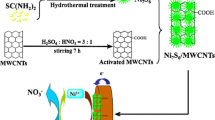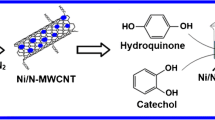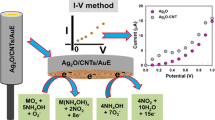Abstract
A nanocomposite consisting of gold nanoparticles deposited on the side walls of functionalised multi-walled carbon nanotubes, Ox-MWCNT-Aunano, was prepared using a simple chemical reduction. The nanoparticles were well dispersed with a mean diameter of 7.5 nm and had a face-centred cubic structure and a gold loading between 2.0% and 2.6% by weight. These gold decorated nanotubes were cast onto a gold electrode to form a uniform and homogeneous sensor. Using cyclic voltammetry, the reduction of Cr(VI) was observed at a peak potential of 0.52 V versus SCE in an acidified H2SO4 solution, pH 2.0. A linear calibration curve with a sensitivity of 0.28 mA mM− 1 and a LOD of 7.2 × 10− 7 M was obtained using constant potential amperometry coupled with rotating disc voltammetry. The electrochemical detection of Cr(VI) was also observed at a MWCNT-modified gold substrate but with a higher LOD, illustrating the advantage of combining the gold nanoparticles with MWCNTs. The sensor showed good selectivity for the detection of Cr(VI) in the presence of Cu(II), chloride and nitrates and in a real water sample. This was attributed to the electropositive reduction potentials of Cr(VI), the acidic H2SO4 supporting electrolyte that provides a well-known cleaning effect at gold, and the size and good dispersion of the gold nanoparticles that minimise particle agglomeration.
Graphical abstract











Similar content being viewed by others
References
Zhitkovich A (2011) Chromium in drinking water: sources, metabolism, and cancer risks. Chem Res Toxicol 24:1617–1629
Anandasadagopan SK, Sundaramoorth C, Pandurangan AK, Nagarajan V, Srinivasan K, Ganapasam S (2017) S-Allyl cysteine alleviates inflammation by modulating the expression of NF-κB during chromium(VI)-induced hepatotoxicity in rats. Hum Exp Toxicol 36(11):1186–1200
Jin W, Zhang Z, Wu G, Tolba R, Chen A (2014) Integrated lignin-mediated adsorption-release process and electrochemical reduction for the removal of trace Cr(VI). RSC Adv 4:27843–27849
WHO (1993) Guidance for drinking water quality, second edition, vol 1, recommendations, WHO, Geneva, pp 45–46
Mohan D, Pittman CU (2006) Activated carbons and low cost adsorbents for remediation of tri- and hexavalent chromium from water. J Hazard Mater 137(2):762–811
McCarroll N, Keshava N, Chen J, Akerman G, Kligerman A, Rinde E (2010) An evaluation of the mode of action framework for mutagenic carcinogens case study II: chromium(VI). Environ Mol Mutagen 51(2):89–111
Lindsay DR, Farley KJ, Carbonaro RF (2012) Oxidation of CrIII to CrVI during chlorination of drinking water. J Environ Monit 14(7):1789–1797
Nan J, Yan X-P (2005) On-line dynamic two-dimensional admicelles solvent extraction coupled to electrothermal atomic absorption spectrometry for determination of chromium(VI) in drinking water. Anal Chim Acta 536(1–2):207–212
Inui T, Fujita K, Kitano M, Nakamura T (2010) Determination of Cr(III) and Cr(VI) at sub-ppb levels in water with solid-phase extraction/metal furnace atomic absorption spectrometry. Anal Sci 26(10):1093–1098
Elci L, Kartal AA, Soylak M (2008) Solid phase extraction method for the determination of iron, lead and chromium by atomic absorption spectrometry using Amberlite XAD-2000 column in various water samples. J Hazard Mater 153(1–2):454–461
Li Y, Pradhan NK, Foley R, Low GKC (2002) Selective determination of airborne hexavalent chromium using inductively coupled plasma mass spectrometry. Talanta 57(6):1143–1153
Shenashen MA, Shahat A, El-Safty SA (2013) Ultra-trace recognition and removal of chromium(VI) ions from water using visual mesocaptor. J Hazard Mater 244–245:726–735
Toal SJ, Jones KA, Magde D, Trogler WC (2005) Luminescent silole nanoparticles as chemoselective sensors for Cr(VI). J Am Chem Soc 127:11661–11665
Bergamini MF, dos Santos DP, Zanoni MVB (2007) Development of a voltammetric sensor for chromium(VI) determination in wastewater sample. Sens Actuators B 123(2):902–908
Vacek J, Mozga T, Cahová K, Pivoňková H, Fojta M (2007) Electrochemical sensing of chromium-induced DNA damage: DNA strand breakage by intermediates of chromium(VI) electrochemical reduction. Electroanalysis 19(19–20):2093–2102
Lin L, Lawrence NS, Thongngamdee S, Wang J, Lin Y (2005) Catalytic adsorptive stripping determination of trace chromium(VI) at the bismuth film electrode. Talanta 65(1):144–148
Welch CM, Nekrassova O, Compton RG (2005) Reduction of hexavalent chromium at solid electrodes in acidic media: reaction mechanism and analytical applications. Talanta 65(1):74–80
Tukur SA, Yusof NA, Hajian R (2015) Linear sweep anodic stripping voltammetry: determination of chromium(VI) using synthesized gold nanoparticles modified screen-printed electrode. J Chem Sci 127(6):1075–1081
Jin W, Wu G, Chen A (2014) Sensitive and selective electrochemical detection of chromium(VI) based on gold nanoparticle-decorated titania nanotube arrays. Analyst 139(1):235–241
Jena BK, Raj CR (2008) Highly sensitive and selective electrochemical detection of sub-ppb level chromium(VI) using nano-sized gold particle. Talanta 76(1):161–165
Rosolina SM, Bragg SA, Ouyang R, Chambers JQ, Xue ZL (2016) Highly sensitive detection of hexavalent chromium utilizing a sol-gel/carbon nanotube modified electrode. J Electroanal Chem 781:120–125
Rudnitskaya A, Evtuguin DV, Costa LC, Graca MPF, Fernandes AJS, Correia MRP, Gomes MTSR, Oliveira JAPB (2013) Potentiometric chemical sensors from lignin-poly(propylene oxide) copolymers doped by carbon nanotubes. Analyst 138(2):501–508
Hasnahena S, Roy M (2018) Sensing of low concentration of ammonia at room temperature by decorated multi-walled carbon nanotube: fabrication and characteristics. Appl Phys A 124(1):1–9
Beiranvand S, Azadbakht A (2017) Electrochemical switching with a DNA aptamer-based electrochemical sensor. Mater Sci Eng C 76:925–933
Moreno-Guzmán M, Agüeí L, González-Cortés A, Yáñez-Sedeño P, Pingarrón JM (2013) Gold nanoparticles/carbon nanotubes/ionic liquid microsized paste electrode for the determination of cortisol and androsterone hormones. J Solid State Electrochem 17(6):1591–1599
Afkhami A, Soltani-Felehgari F, Madrakian T, Ghaedi H (2014) Surface decoration of multi-walled carbon nanotubes modified carbon paste electrode with gold nanoparticles for electro-oxidation and sensitive determination of nitrite. Biosens Bioelectron 51:379–385
Wang Z, Shirley MD, Meikle ST, Whitby RDL, Mikhalovsky SV (2009) The surface acidity of acid oxidised multi-walled carbon nanotubes and the influence of in-situ generated fulvic acids on their stability in aqueous dispersions. Carbon 47(1):73–79
Hanelt S, Orts-Gil G, Friedrich JF, Meyer-Plath A (2011) Differentiation and quantification of surface acidities on MWCNTs by indirect potentiometric titration. Carbon 49(9):2978–2988
Sreeja R, Aneesh PM, Hasna K, Jayaraj KM (2011) Linear and nonlinear optical properties of multi walled carbon nanotubes with attached gold nanoparticles. J Electrochem Soc 158(10):K187–K191
Hou X, Wang L, Wang X, Li Z (2011) Coating multiwalled carbon nanotubes with gold nanoparticles derived from gold salt precursors. Diam Relat Mater 20(10):1329–1332
Cullity BD (1956) Elements of X-ray diffraction. Addison-Wesly, Boston
Gu H, Rapole S, Haung Y, Cao D, Luo Z, Wei S, Guo Z (2013) Synergistic interactions between multi-walled carbon nanotubes and toxic hexavalent chromium. J Mater Chem 1(6):2011–2021
Zheng H, Lin L, Okezaki Y, Kawakami R, Sakuraba H, Ohshima T, Takagi K, Suye SI (2010) Electrochemical behavior of dye-linked-proline dehydrogenase on glassy carbon electrodes modified by multi-walled carbon nanotubes. J Nanotechnol 1:135–141
Environmental Protection Agency (2010) The provision and quality of drinking water in Ireland. A report for the year 2010. Environmental Protection Agency, Washington, DC, pp 102
Colaianni L, Kung SC, Taggart DK, Picca RA, Greaves J, Penner RM, Cioffi N (2014) Reduction of spectral interferences using ultraclean gold nanowire arrays in the LDI-MS analysis of a model peptide. Anal Bioanal Chem 406(19):4571–4583
Tsai MC, Chen P-Y (2008) Voltammetric study and electrochemical detection of hexavalent chromium at gold nanoparticle-electrodeposited indium tinoxide (ITO) electrodes in acidic media. Talanta 76(3):533–539
Jin W, Yan K (2015) Recent advances in electrochemical detection of toxic Cr(VI). RSC Adv 5:37440–37450
Acknowledgements
The authors would like to acknowledge funding from the Environmental Protection Agency, Ireland.
Author information
Authors and Affiliations
Corresponding author
Rights and permissions
About this article
Cite this article
Breslin, C.B., Branagan, D. & Garry, L.M. Electrochemical detection of Cr(VI) with carbon nanotubes decorated with gold nanoparticles. J Appl Electrochem 49, 195–205 (2019). https://doi.org/10.1007/s10800-018-1259-2
Received:
Accepted:
Published:
Issue Date:
DOI: https://doi.org/10.1007/s10800-018-1259-2




